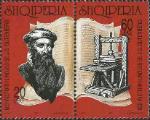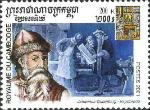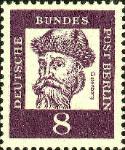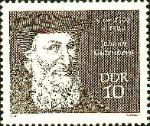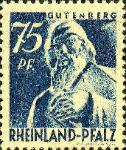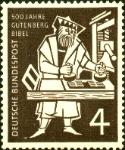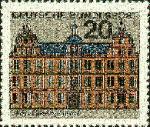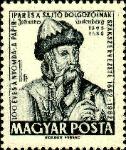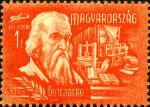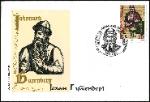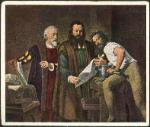| Gutenberg and His 42-line Bible |
Johann Gutenberg (c. 1400-68) did not invent printing. After all, the Chinese had already employed various printing
methods for centuries, and “block books” were printed in Europe by the early 15th century. Gutenberg was fortunate,
however, in that his native language was alphabetic, not ideographic. An alphabetic system requires a finite number of
symbols to render; thus Gutenberg had only to design and cast about 300 different pieces of type to print his 42-line
Bible, including upper and lower case letters, abbreviations, ligatures, punctuation marks, etc. Not so with the Chinese
language, which requires about 3,000 different characters to print a typical Chinese newspaper or magazine, and at least
6,000 characters for most Chinese literature, technical writing, or classical literature. A system like that of Gutenberg
was not practical in the 15th century for printing the Chinese language.
Gutenberg was born Johann Gensfleisch zum Gutenberg in Mainz, Germany and moved to Strasbourg sometime before
1434. Legal records show that he was involved in a partnership to produce metal hand mirrors used by pilgrims visiting
holy sites. The skills acquired in this endeavor must have been useful to him as he developed a method of making metal
type for printing. Sometime between 1444 and 1448, Gutenberg returned to Mainz, but there is little information about
his activities for the next decade.
By the 1450s, Gutenberg had developed a system that made large-scale production of text feasible, including a new oil-
based ink, a suitable metal alloy for typecasting (one that hardened quickly in a mold), and a device for quickly casting
and extracting moveable metal type. Gutenberg’s press, perhaps adapted from wine or bookbinding presses already in use,
could now complete in weeks what a team of scribes formerly produced over their lifetimes.
Gutenberg’s talents were manifold, including the capabilities of a mechanical inventor, a craftsman, a salesman, and
above all the genius to conceive and push through a novel and highly complex enterprise. He also had a fine eye for the
design of the printed page, which he based upon manuscript exemplars.
Gutenberg’s press is believed to have produced about 180 copies of the 42-line Bible, a quarter of them on vellum and the
rest on paper. Fewer than 50 copies survive today, and many of these only as fragments. Most of the complete or nearly
complete surviving Bibles are impressively large, nearly 1,300 pages divided into two stout volumes. More impressive,
however, is the meticulous design of the pages: the decorative initials; the graceful proportions of the twin columns on
each page; the crisp, handsome textura typeface emphasizing vertical and horizontal elements of the letters. Gutenberg’s
typeface faithfully replicated the formal manuscript hand of the time. A few surviving copies are especially sumptuous,
with elaborate initials and floral marginal designs that illuminators added by hand after printing.
As with subsequent printed books of the era, empty spaces were left in the text for large initial letters, which were later
drawn in by hand. The red chapter headings, or rubrics, were originally printed with a different ink, requiring a second
pass through the press for each sheet; this was deemed too time-consuming, it seems, as on later pages they, too, were
added by hand. The earlier pages of most 42-line Bibles have only 40 lines of text, but the type was later shaved down so
that two additional lines per page could be added, probably to reduce material and labor costs. Gutenberg apparently
decided to extend the print run at a certain point, however, because some surviving copies show 42 lines on every page.
Surprisingly, none of Gutenberg’s 42-line Bibles contain printing or publication information. This omission is perhaps in
keeping with a certain modesty inherent in Gutenberg's project, which, while radically speeding up the production of
books, maintained the elegance of their hand-lettered precursors. The most remarkable aspect of Gutenberg's press, in
fact, may be that it combined the very latest in efficiency with a hands-on attention to craftsmanship and design. He
demonstrated that the printed word edifies, as both medium and message—a welcome notion in our own day, when it's
often reduced to simply “hard copy” or “a paper trail.”
It should be noted that even the most familiar engraved portraits of Gutenberg were made long after his death and are
based on speculations about his appearance. The same holds true for depictions of his printing press.
methods for centuries, and “block books” were printed in Europe by the early 15th century. Gutenberg was fortunate,
however, in that his native language was alphabetic, not ideographic. An alphabetic system requires a finite number of
symbols to render; thus Gutenberg had only to design and cast about 300 different pieces of type to print his 42-line
Bible, including upper and lower case letters, abbreviations, ligatures, punctuation marks, etc. Not so with the Chinese
language, which requires about 3,000 different characters to print a typical Chinese newspaper or magazine, and at least
6,000 characters for most Chinese literature, technical writing, or classical literature. A system like that of Gutenberg
was not practical in the 15th century for printing the Chinese language.
Gutenberg was born Johann Gensfleisch zum Gutenberg in Mainz, Germany and moved to Strasbourg sometime before
1434. Legal records show that he was involved in a partnership to produce metal hand mirrors used by pilgrims visiting
holy sites. The skills acquired in this endeavor must have been useful to him as he developed a method of making metal
type for printing. Sometime between 1444 and 1448, Gutenberg returned to Mainz, but there is little information about
his activities for the next decade.
By the 1450s, Gutenberg had developed a system that made large-scale production of text feasible, including a new oil-
based ink, a suitable metal alloy for typecasting (one that hardened quickly in a mold), and a device for quickly casting
and extracting moveable metal type. Gutenberg’s press, perhaps adapted from wine or bookbinding presses already in use,
could now complete in weeks what a team of scribes formerly produced over their lifetimes.
Gutenberg’s talents were manifold, including the capabilities of a mechanical inventor, a craftsman, a salesman, and
above all the genius to conceive and push through a novel and highly complex enterprise. He also had a fine eye for the
design of the printed page, which he based upon manuscript exemplars.
Gutenberg’s press is believed to have produced about 180 copies of the 42-line Bible, a quarter of them on vellum and the
rest on paper. Fewer than 50 copies survive today, and many of these only as fragments. Most of the complete or nearly
complete surviving Bibles are impressively large, nearly 1,300 pages divided into two stout volumes. More impressive,
however, is the meticulous design of the pages: the decorative initials; the graceful proportions of the twin columns on
each page; the crisp, handsome textura typeface emphasizing vertical and horizontal elements of the letters. Gutenberg’s
typeface faithfully replicated the formal manuscript hand of the time. A few surviving copies are especially sumptuous,
with elaborate initials and floral marginal designs that illuminators added by hand after printing.
As with subsequent printed books of the era, empty spaces were left in the text for large initial letters, which were later
drawn in by hand. The red chapter headings, or rubrics, were originally printed with a different ink, requiring a second
pass through the press for each sheet; this was deemed too time-consuming, it seems, as on later pages they, too, were
added by hand. The earlier pages of most 42-line Bibles have only 40 lines of text, but the type was later shaved down so
that two additional lines per page could be added, probably to reduce material and labor costs. Gutenberg apparently
decided to extend the print run at a certain point, however, because some surviving copies show 42 lines on every page.
Surprisingly, none of Gutenberg’s 42-line Bibles contain printing or publication information. This omission is perhaps in
keeping with a certain modesty inherent in Gutenberg's project, which, while radically speeding up the production of
books, maintained the elegance of their hand-lettered precursors. The most remarkable aspect of Gutenberg's press, in
fact, may be that it combined the very latest in efficiency with a hands-on attention to craftsmanship and design. He
demonstrated that the printed word edifies, as both medium and message—a welcome notion in our own day, when it's
often reduced to simply “hard copy” or “a paper trail.”
It should be noted that even the most familiar engraved portraits of Gutenberg were made long after his death and are
based on speculations about his appearance. The same holds true for depictions of his printing press.
- Please CLICK on an image for an ENLARGED version.
These two stamps were issued on
20 March 1997 to mark the
possible 600th birth anniversary
of Johann Gutenberg (1397?
-1468). The 20-lek value has
Gutenberg’s portrait, and the 60-
lek value displays a possible
configuration of his printing
press (Albania, Scott #2529-2530).
20 March 1997 to mark the
possible 600th birth anniversary
of Johann Gutenberg (1397?
-1468). The 20-lek value has
Gutenberg’s portrait, and the 60-
lek value displays a possible
configuration of his printing
press (Albania, Scott #2529-2530).
Bulgaria issued the stamps on
this First Day Cover to mark the
500th anniversary of the
beginning of Gutenberg’s work,
ca. 1440, and the 100th
anniversary of the first printing
press in Bulgaria, operated in
Samokov by Nikola Karastoyanov
(Bulgaria, Scott #384-385).
this First Day Cover to mark the
500th anniversary of the
beginning of Gutenberg’s work,
ca. 1440, and the 100th
anniversary of the first printing
press in Bulgaria, operated in
Samokov by Nikola Karastoyanov
(Bulgaria, Scott #384-385).
This souvenir sheet was issued
on 20 May 1968 to mark the
500th death anniversary of
Gutenberg. Both stamps on the
sheet (issued individually as
Scott #C69-C70) have the
Gutenberg Statue Monument in
Mainz as foreground, with the
Strasbourg Cathedral in the
background on the 45-franc
value, and a rendering of what
Gutenberg’s printing press
might have looked like on the
100-franc value (Dahomey, Scott
#C70a).
on 20 May 1968 to mark the
500th death anniversary of
Gutenberg. Both stamps on the
sheet (issued individually as
Scott #C69-C70) have the
Gutenberg Statue Monument in
Mainz as foreground, with the
Strasbourg Cathedral in the
background on the 45-franc
value, and a rendering of what
Gutenberg’s printing press
might have looked like on the
100-franc value (Dahomey, Scott
#C70a).
As part of its Millennium
commemoration in 2001,
Cambodia issued a set of six
stamps (Scott #2052-2057), the
first of which portrays Gutenberg’s
portrait, with a background
showing him inspecting a sheet
just removed from the press, and
a smaller inset showing a
pressman working a press. The
portrait is a hypothetical one of
Johann Gutenberg rendered in
1584. (Cambodia, Scott #2052).
commemoration in 2001,
Cambodia issued a set of six
stamps (Scott #2052-2057), the
first of which portrays Gutenberg’s
portrait, with a background
showing him inspecting a sheet
just removed from the press, and
a smaller inset showing a
pressman working a press. The
portrait is a hypothetical one of
Johann Gutenberg rendered in
1584. (Cambodia, Scott #2052).
Johann Gutenberg is included
among a set of 15 portraits (Scott
#9N176-9N190) issued in 1961
and 1962 for use in the
American, British, and French
Occupation Sectors of Berlin
(Germany, Scott #9N178).
among a set of 15 portraits (Scott
#9N176-9N190) issued in 1961
and 1962 for use in the
American, British, and French
Occupation Sectors of Berlin
(Germany, Scott #9N178).
Included first among a series
of portraits issued on 20
January 1970 is this
10-pfennig value of Gutenberg
(German Democratic Republic,
Scott #1167).
of portraits issued on 20
January 1970 is this
10-pfennig value of Gutenberg
(German Democratic Republic,
Scott #1167).
The Palatinate (in German: Pfalz)
is a region in southwestern
Germany that occupies more than
a quarter of the German federal
state of Rhineland-Palatinate
(Rheinland-Pfalz). During the
occupation of Germany after
World War II, the Palatinate was
occupied by French Forces. The
French reorganized their
occupation Zone by founding new
states and, in 1947, the
Palatinate was combined with
Rheinhessen (a part of Hesse), a
part of the Prussian Province of
Nassau, and the southern part of
the Prussian Rhine Province to
form the German federal state of
Rhineland-Palatinate. This
depiction of the upper portion of
the Gutenberg Statue Monument
in Mainz is the 75-pfennig value,
one of 15 stamps issued in 1947
and 1948 (Germany—Rhine
Palatinate, Scott #6N13).
is a region in southwestern
Germany that occupies more than
a quarter of the German federal
state of Rhineland-Palatinate
(Rheinland-Pfalz). During the
occupation of Germany after
World War II, the Palatinate was
occupied by French Forces. The
French reorganized their
occupation Zone by founding new
states and, in 1947, the
Palatinate was combined with
Rheinhessen (a part of Hesse), a
part of the Prussian Province of
Nassau, and the southern part of
the Prussian Rhine Province to
form the German federal state of
Rhineland-Palatinate. This
depiction of the upper portion of
the Gutenberg Statue Monument
in Mainz is the 75-pfennig value,
one of 15 stamps issued in 1947
and 1948 (Germany—Rhine
Palatinate, Scott #6N13).
This wonderful depiction of
Gutenberg using a pair of ink
balls to ink a form locked on the
bed of his press is based upon a
woodcut by Jost Amman (ca.
1539-1591), a Swiss designer,
draftsman, painter, and
printmaker. It was issued on 5
May 1954 to commemorate the
500th anniversary of the
publication of Gutenberg’s 42-
line Bible (Germany, Scott #723).
Gutenberg using a pair of ink
balls to ink a form locked on the
bed of his press is based upon a
woodcut by Jost Amman (ca.
1539-1591), a Swiss designer,
draftsman, painter, and
printmaker. It was issued on 5
May 1954 to commemorate the
500th anniversary of the
publication of Gutenberg’s 42-
line Bible (Germany, Scott #723).
The Gutenberg Museum
represents Mainz in a series of
stamps (Scott #869-879A)
commemorating the state
capitals of Germany (Germany,
Scott#875).
represents Mainz in a series of
stamps (Scott #869-879A)
commemorating the state
capitals of Germany (Germany,
Scott#875).
The centennial of the Printers’
and Papermakers’ Union in
Hungary is commemorated by two
stamps, one of which is a portrait
of Gutenberg (Hungary, Scott
#1455).
and Papermakers’ Union in
Hungary is commemorated by two
stamps, one of which is a portrait
of Gutenberg (Hungary, Scott
#1455).
Part of a series of air mail
stamps issued on 15 May 1948
commemorating Explorers and
Inventors, this striking issue
depicts Johann Gutenberg in
the foreground, with his
printing press and a
20th-century newspaper press
in the background (Hungary,
Scott #C53).
stamps issued on 15 May 1948
commemorating Explorers and
Inventors, this striking issue
depicts Johann Gutenberg in
the foreground, with his
printing press and a
20th-century newspaper press
in the background (Hungary,
Scott #C53).
The second value in a set of
two commemorating “Printing
Pioneers,” the 30-denar value
(shown here on a First Day
Cover)has a portrait of
Gutenberg holding a book,
flanked by a wooden press,
with a page from the 42-line
Bible serving as background.
The cachet is an oft-used
portrait of Gutenberg
(Macedonia, Scott #193).
two commemorating “Printing
Pioneers,” the 30-denar value
(shown here on a First Day
Cover)has a portrait of
Gutenberg holding a book,
flanked by a wooden press,
with a page from the 42-line
Bible serving as background.
The cachet is an oft-used
portrait of Gutenberg
(Macedonia, Scott #193).
The United States commemorated
Gutenberg’s achievement on 30
September 1952 with this 3¢
value. The picture on the left side
of the stamp is based on a detail
of a mural painted by Edward
Lansing (1906-1981) in the New
York Public Library. It shows
Gutenberg presenting a proof of
his Bible to the Archbishop, Duke
Adolph Nassau, the Elector of
Mainz. The appearance of this
stamp was marked by many First
Day Covers, several of which are
here reproduced (United States,
Scott #1014).
Gutenberg’s achievement on 30
September 1952 with this 3¢
value. The picture on the left side
of the stamp is based on a detail
of a mural painted by Edward
Lansing (1906-1981) in the New
York Public Library. It shows
Gutenberg presenting a proof of
his Bible to the Archbishop, Duke
Adolph Nassau, the Elector of
Mainz. The appearance of this
stamp was marked by many First
Day Covers, several of which are
here reproduced (United States,
Scott #1014).
United States, Scott #1014, on First Day Covers
Gutenberg’s likeness has also appeared on many poster stamps and cinderellas, as well as currency, a
small selection of which is here reproduced:
small selection of which is here reproduced:
